The History of Editorial Games, Part One
Simultaneously posted on Bogost’s News Games blog.
The history of the editorial game began not with a bang, but with three. The first (the Big Bang of editorial games, as well as a couple other genres, so to speak) was the wide adoption of Flash in the creation of casual webgames. We can date this as sometime around August 2000, when Macromedia released Flash 5 with ActionScript 1.0, XML functionality, and SmartClips (an early form of components). Flash 5 and Flash MX were instrumental in the popularization of gaming portals such as AddictingGames.com (which we will return to near the end) in late 2001.
The second bang occurred on September 11th, 2001. Al-Qaeda’s attack on American soil plunged the country into what seems today to be a perpetual war, becoming the most visible public issue (until, perhaps, our most recent economic downturn) both in the United States and abroad. The war on terror is a polarizing issue, leading to an explosion of opinion-based publishing on the Internet. Opinions are cheap, and we’re quick to form them. Flash isn’t incredibly cheap unless you’re a student, but it is relatively easy to quickly make a game with it if you have any knowledge of keyframe animation or basic object-oriented programming.
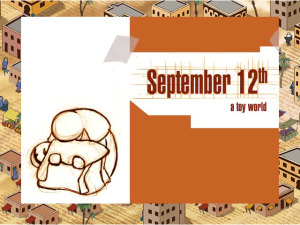
Finally, the prior currents converge in late September of 2003 (I’m now finished with the “bang” metaphor): Gonzalo Frasca launches newsgaming.com with a controversial “toy world” entitled September 12th. Frasca had casually created a political game called Kabul Kaboom during a transcontinental flight at the beginning of the war in Afghanistan, and the game’s unexpected viral popularity led him to develop September 12th—an elegantly simple game about the dangerous assumptions of tactical missile strikes on terrorist pockets—over the course of the next few months. It employs an early example of what Ian Bogost calls “the rhetoric of failure”—a game that can only be “won” by not playing it at all. September 12th became wildly popular, gaining mainstream media attention and inspiring almost a decade of political Flash games (recently winning the Knight Foundation’s Lifetime Achievement award for newsgames at this year’s Games for Change).
Next week I’m going to write a post that will explain exactly why I’m calling September 12th an “editorial game” instead of a “newsgame.” This post skips on a lot of theoretical jargon and definitional hair-splitting so that readers new to the idea of political games might come to understand how a fledgling game genre is developed and refined over time (from a design perspective), forged in the heat of playful experimentation as opposed to through top-down formalist definitions—meaning that, if this were an academic paper, we would be able to show how most editorial games are built upon common unit operations carried over from other forms of casual games (something I argue a bit at the end of an article on relevance).
Water Cooler Games, a website maintained by Frasca and Bogost, tracked the development of what they labelled “newsgames” (which we can now separate into the sub-genres of newsgames, “editorial games,” “political games,” and “documentary games” with the benefit of hindsight) from 2003 until today. The year 2004 saw the creation of Madrid—Frasca’s follow-up to September 12th that we’ve covered elsewhere—an editorial game that simply asks one to remember a tragic event, an early entry into the documentary genre called John Kerry’s Silver Star Mission by Kuma/War, and the controversial doc game JFK Reloaded, wherein one tries to mimic the exact shots fired on President Kennedy (supposedly) by Lee Harvey Oswald. Ed Halter notes the popularization of Osama bin Laden whack-a-mole games in the mid-2000s, but no other prominent editorial games appear to have popped up until early 2006.
Here begins a series of chronologically-ordered micro reviews, for which I will provide meta-commentary throughout and at the end of the article. For the most part, I will be embellishing on the notes made by Frasca and Bogost as they documented the editorial games made through the bulk of 2006.
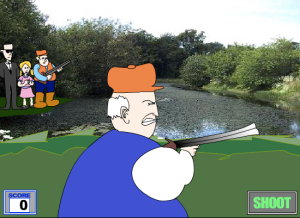
Dick Cheney Quail Hunt
Produced by the Huffington Post in February of 2006, this artifact barely deserves to bear the name “game” (as Bogost points out here). Cheney stands in front of three onlookers (a little girl, another hunter, and a Secret Service agent?) with a shotgun. A bird eventually flies onto the screen, at which point you can click a button that says “Shoot.” No matter when you click the button, Cheney will turn and randomly shoot one of the three onlookers. Following a prominent news fiasco following Dick Cheney’s shooting of a fellow hunter, this game employs the rhetoric of failure to poke fun at how bad a shot Cheney is. When you inevitably fail, the creators provide two educational links for you: one about Cheney and canned hunting, and one to an “animal-friendly” vegan podcast. Strangely, the text bubble above these links encourages you to try playing again and “aim better next time.” Perhaps the only interesting touch is the score tally in the bottom left corner, which will never rise past zero. Ian noted at the time of its release that this can truly be called a “newsgame” in Miguel Sicart’s sense of the word (“ephemeral and timely,” explored fully in my next post), because it was released so soon after the news event.

Dick Cheney’s Texas Takedown
A day or two after the game by the Huffington post was released, another came out that was slightly more gamelike. Cheney, donning a Confederate flag baseball cap, wanders an empty field shooting at clones of Harry Whittington (holding their arms above their heads as though in a stick-up) that walk back and forth horizontally. As Ian notes, it would have made sense to have Cheney actually trying to shoot quail instead of gunning down scores of Harrys that appear to be wandering where they shouldn’t. You receive ten points every time you shoot down Harry. If you score well, a cartoon Devil-Cheney appears and the designers ask you how you plan to carry out the Apocalypse. If you don’t shoot at all, Cheney appears as a Fairy Godmother, a banner shouts “You Suck,” and the menu tells you that “we solve our problems with violence in America, remember?” Unlike the Huffington Post “game,” this one isn’t really a direct critique of canned hunting; on the other hand, it is also more gamelike and doesn’t preach as much through text and hyperlinks. It seems to be much more generally interested in making fun of Cheney’s (and America’s) bellicose nature (which may or may not have anything to do with the Whittington shooting).
In March of 2006, Paolo Pedercini (the personal hero of everyone who studies political games) premiered The McDonald’s Game at a festival in Torino—an important milestone in the history of the political game—which we have covered elsewhere (his games skirt the fine line between editorial and political game, and they don’t really fit in neatly with the short-form games we’re covering in this particular history).

Hothead Zidane
Hothead Zidane was created by an Italian football fan soon after Zidane’s disgraceful headbutt during the World Cup finale. Frasca asserts that it must have been thrown together in a few hours considering the lack of a score or any difficulty. The player controls Zidane, who roams through a small bit of field as clones of his Italian adversary (Materazzi) come at him waves. After a few successful headbutts, Zidane is thrown a red card and the game is over—an example of the rhetoric of failure being used to comment on the fact that a past event cannot be altered. One last news image shows Zidane with his back to the Cup, head bowed in shame. Frasca notes the “crude graphics,” but I believe the designer actually captured the quality of watching a soccer game on a small CRT screen quite well. The character movement, repetitive attack, and sound effects all reminded me of a Shinobi game (an early ninja brawler for the Sega Genesis). Played with the mouse, I think it provides a closer level of identification with the Zidane avatar than the keyboard-controlled Cheney games. Within a week, Addicting Games had revamped the game with a score system that had multiple levels of hit detection (more points for upper body, bonus points for a headshot), faster scrolling of Materazzi clones, higher graphical clarity, and enhanced sound effects. They also released the source code so other gamers/modders/designers could make their own version.

Israel-Lebanon Wargames
“No security-political situation is complete without its idiotic web games, which allow tensions to be released,” states an article by Israeli Culture news source Ynet. In July of 2006, Frasca posted (by way of Ed Halter’s blog for his book on wargames) two games about Israel’s war with Lebanon’s Hezbollah leadership—Secretary General Hassan Nasrallah in particular. The first game, simply called Nasralla, is a whack-a-mole game featuring Nasrallah’s head popping up over what Frasca thinks is a Google Map of Beirut. The game apes Frasca’s own missile delay mechanic from September 12th, leading the player to end up spamming random missile strikes in order to successfully land a bomb (one strategy is to aim near the bottom of the screen in order to cheat the delay mechanic). This is arguably almost as sophisticated as Frasca’s initial use of the delay, because (as the Ynet article suggests) it “encourages guessing”—placing the player in the mindset of a zealous IDF leader. Of course, nothing else about the game is as interesting or well-crafted as Frasca’s original. When the player scores a hit, a message in Hebrew pops up to declare: “Very good, chief of staff. Come back to work now.” It is unclear whether this game is sarcastically critical of Israel’s administration or enthusastically in support of the war on Lebanon.
Halter connects the first game to the Whack Osama games that hit the net over the course of the mid-2000’s, positing them as successors to the earlier form of the “celebrity assassination” game. Bogost makes an observation on the prominent role of whack-a-mole in political games, which Frasca ascribes to the fact that it is relatively easy to use a face for a Flash game because it cuts down on the need to animate a body.
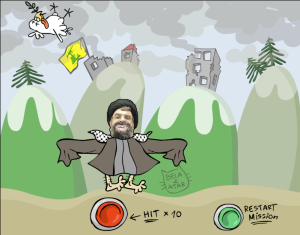
The second game, also called Nasralla, is similar to Cheney Quail Hunt from the perspective of control. Nasrallah, animated to move and sound like a grotesque vaudeville chicken, runs back and forth horizontally at a constant pace; players hit a red button in order to drop a variety of items (bombs, dead doves, toilets) on his head as he passes below them. Frasca notes that one of these, a severed pig’s head, is a symbol of disrespect to Muslims (because of Halal eating practices). Each successful hit nets a chicken-squawk from Nasrallah, and after scoring ten hits the player is treated to a message from the two creators: “U did it! We luv u! xxx” The mix of racist caricature and children’s text message-speak is truly disturbing, perhaps highlighting the childlike glee that some zealous Israelis feel at the prospect of war (in propaganda or actual violence) with their Muslim enemies.
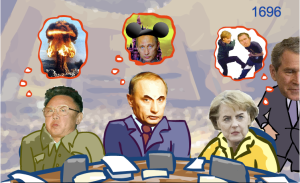
Bush Backrub
In early August of 2006, Bogost reports that a Flash game has been produced rather quickly after Bush performed an “impromptu backrub” on German chancellor Angela Merkel. Bush creeps behind three world leaders—Kim Jong Il, Vladimir Putin, and Merkel—during a UN assembly. Meters below them slowly empty, and the player must lead Bush behind each leader with the mouse, click to place Bush’s hands on their shoulders, and then jerk the mouse back-and-forth to perform a “Texas backrub.” This seems to be a new mechanic in newsgames at this point, one that I’ve seen used to perform a similar action in gay sex games made in Flash (NSFW, commentary by Denis Farr). When the “comfort” meters on each world leader hit certain low levels, slightly amusing (read: slightly offensive) thought bubbles appear above their heads. The player is scored for how long they keep the game going, but I didn’t perceive any quickening in the pace of the game (I simply tired and let myself slow down after awhile). As Ian notes, this isn’t really criticizing the Bush administration in a serious way but simply recognizing the hilarity of a prominent fluke of world news.
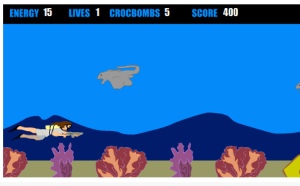
Terri Irwin Stingray Revenge
On September 7th, a celebrity tabloid newsgame was released, returning the genre to its popular roots in games created about Hollywood sleaze (remember: Halter traced whack-a-mole mechanics back to such games). Tabloid newsgames seem closer in design and purpose to editorial games than to proper newsgames, because they have little to no journalistic intent. The game deals with the recent death of Crocodile Hunter Steve Irwin. Frasca begins his post on the game by explaining that he and Ian had talked the day before about what such a game might look like before deciding definitively that it shouldn’t be made. The next day, a game was posted online wherein the player controls Terri Irwin slaughtering stingrays to avenge her husband’s death. Unfortunately the game has been removed from all original hosting sites, and I couldn’t find a rogue copy of it to play. Apparently the game was taken down after numerous negative reactions from the public (even WCG got a lot of comments arguing for censorship). Mechanically it appears to have been most like the Hothead Zidane and Cheney Texas Takedown games—waves of stingrays swim horizontally toward Terri, who can swim up and down to shoot them with a harpoon. Frasca saw this as providing a kind of societal catharsis for the tragedy, while many commenters protested the content of the game on the basis of the Irwin family’s continued love of and support for wildlife (even the violent kind).
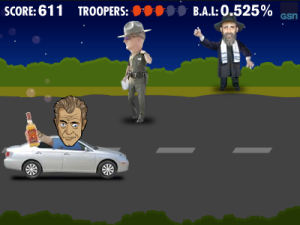
So you think you can drive, Mel?
Following hot on the heals of the Irwin game, Gameology came across another celebrity tabloid game about Mel Gibson’s widely publicized drunk-driving-and-ethnic-slurring incident. Oddly enough, this artifact is by far the most technically sophisticated editorial game from this period (as Ian notes, it was made by The Game Show Network, which explains the production values)! A caricature of Mel’s face hangs out the right side of his car (Hollywood and Australia are basically the same place) as he speeds down the highway. The screen scrolls to the side (slightly uncommon at this point in the genre), and players can only control Mel’s car on the vertical plane. One’s score rises slowly as the game goes on; grabbing bottles of whiskey increases the score considerably, but it also raises Mel’s blood alcohol content. As his BAC rises, it becomes more and more difficult to control one’s movement as the car lags behind, jump forward, and bounces up-and-down. There are two enemies: Jews and cops. Jews throw stars of David at Mel’s car from the top of the screen, and if one hits the player loses 25 points. Hitting a cop doesn’t decrease the score, but once the player hits five of them the game is over. The rhetoric is clear: Mel has a single-minded obsession to drink, he despises the ever-present Hollywood Jews (while playing, I vocally cursed my own tribe as they threw stars at me), and he sees the law as little more than an obstacle to be blown through. Of all the editorial games we’ve looked at that serve as indictments of character (the Bush and Cheney games), this one comes closest to accurately proceduralizing and conveying the negative attributes of a personality.
On September 19th, Bogost announced that Persuasive Games had inked a deal to produce a series called The Arcade Wire games for Addicting Games (told you we’d come back to them) and Shockwave. It was an effort to show what a newsgame might look like it it were a deep, procedural interpretation of the news—a return to the level of craft established by Frasca with September 12th. The series began with Airport Security. By the end of the month, Jane McGonigal came across a NYTimes article detailing a newsgame, called Counter Strike, funded by the Iranian government, which shows players how to disrupt the world oil supply by destroying a US tanker in the Straight of Hormuz. Jane and Ian wondered aloud if this were in fact the first ludic “geopolitical act.” By no means ushering in the death of the one-off editorial or tabloid newsgame, this at least marks a good place for us to pause.
We can observe that, over the course of only half a year, an explosion of creative energy divorced from the admittedly academic attitude of Frasca and Bogost has occurred (which, of course, they were incredibly enthusiastic to watch over and comment on). This period marks the time between the creation of Madrid, after which Frasca ceased making newsgames, and the return to form for the genre that we see in the Arcade Wire games. Unlike Frasca’s games and the Arcade Wire series, it is unclear whether these casually created editorial games have any journalistic intent whatsoever. They certainly make no attempt to hide the fact of their bias or to present any meaningful “facts” (in the journalist’s sense) to the player. These artifacts are opinion pieces, in the truest sense of the word (and often not incredibly articulate). In some cases, they represent early steps toward ludic citizen journalism: games made by ordinary (non-industry, non-journalist) people who know how to program and care enough/find enough stuff funny about a news issue.
We can generalize a bit on their formal qualities, noting that editorial games are usually quickly-produced and mechanically-simplistic (Dick Cheney Quail Hunt and Hothead Zidane); use static photographs or caricatures of faces in order to avoid costly animation; often come in pairs (the Cheney and Nasrallah games); their mechanics tend to derive directly from more popular Flash games (whack-a-mole from the “celebrity assassination” sub-genre) or earlier editorial games (Nasralla #2 borrowing the delay and reticle from September 12th); and although similar in graphical quality and play, they cover a range of topics from serious political issues (war in the Middle East), the embarrassing foibles of unpopular politicos (Bush Backrub and the Cheney games), and celebrity news or sleaze (Terri Irwin Stingray Revenge and the Mel Gibson game, respectively).
The level of thought that has gone into the conception and the design of these games varies wildly, which I would argue is incredibly healthy for the genre as a whole. Releasing the source code of some of these games—as Addicting Games did for Hothead Zidane, and as a documentary game developer Overdog did for a game called Silence Variations on the theft of a few Edward Munch paintings—is another important and under-explored phenomenon (which I will be covering in my Master’s thesis next year). In the next article, I will analyze the definitional distinctions made between Frasca and Miguel Sicart on “the newsgame.” After that, I will analyze the Arcade Wire series produced by Persuasive Games and continue on to the next stage in the history of the editorial game.


So I like that people actually think about these games considering how many of them there are. The question I have has to do with where the line is drawn. Take for instance, these two games:
The Virginia Tech RPG and the Columbine Massacre RPG
http://lparchive.org/LetsPlay/VTech_Columbine/
Is the difference just ease of play / Flash?
That’s a whole bunch of issues rolled up into one. First is that Super Columbine Massacre is a cross between editorial and documentary, in that it has a distinct opinion on the actions of the gunners (they burn in Hell at the end). The VTech game is really only documentary, because it simply recreates the events as they happened and punishes you for not following the course of events properly. The first was made in RPG Maker, the latter in Flash. Although I’m inclined to say that the VG Massacre one is trashy because of its presentation, the maker of Columbine RPG has endorsed and defended it.
Both of them have huge presentation issues. A big part of this business is the intent of the creator–I don’t want to fall into an intentional fallacy, but I think the second game suffers because the creator had no idea what the Hell he was doing when he made the game.
I might disagree as to the “only documentary” classification of the VTech game. If the rules punish players for deviating from the pre-written story, doesn’t that teach the players to consign themselves to a pre-determined fate?
Oh snaps it’s the E-Money! Good question, man. It’s a tough call, and I guess we won’t agree, but I’m inclined to say that doesn’t really change the genre. I think that probably comes down to an intra-genre distinction (like “free” and “terse” documentary game, or something like that). Reason I say that is because the same mechanic of failure for deviation occurs in John Kerry Silver Star Mission: if you shoot a civilian the game is over, to enforce a view of Kerry as righteous or whatever (I mean, he was never accused of killing civilians, so it wouldn’t make sense to do it). This mechanic actually showed up earlier in that comic-book shooter game XIII for the XBOX–at one point the protagonist has to rob a bank, but he’s a good guy on the run from conspirators… so you could take cops hostage, but if you shot them you’d have to restart the checkpoint.
Basically I’m saying that’s a cross-genre mechanic that basically reinforces character trait development. In the case of documentary, it enforces a strict playthrough so the player will know “who the character is” and “exactly what they did” (which of course isn’t completely true either. Thanks for the query! I’ll think about it some more during the day!
Considering the content of these games, is it weird to dive in to so many of them? Like, do you feel dirty and/or gross?
Racism is the only thing that really gets to me. The second Nasrallah game made me a bit nauseated, but not as much as the game where you shoot Mexican immigrants (did you catch that little scandal when it popped up–politician getting fired for passing the game around with his official email address?).
I’ve been studying these things for a year and only now have I gathered the courage to try to write about them, if that tells you anything. Usually a commenter shows up and says, “You’re wasting your life, these games are nothing but fucking traffic grabbers.”
“You’re wasting your life, these games are nothing but fucking traffic grabbers.”
This is precisely the reason to write about them. Why are they “fucking traffic grabbers?”
I mean, it’s one thing to just assume controversy draws crowds, it’s a whole other thing to try and figure out why it causes the controversy aside from the obvious. For example, the controversy caused by Muslim Massacre was pretty intense:
http://en.wikipedia.org/wiki/Muslim_Massacre
Here, there’s a whole slew of things going on here and looking at where people are coming from who play the game would be just as interesting as looking at the public outcry.
There’s another one where the designer’s intentions are so important. The fact that he was able to diffuse the situation by apologizing and claiming legitimate critique is disappointing because it makes everybody else look bad. I really like how the Super Columbine Massacre dude has emerged as this voice of conscience.
I don’t know if I can guess at why people play them though. We’d need legitimate qualitative research, which I’m not in a position to undertake. What I can do is analyze how and (maybe) why they’re made.
I really think you could through free communication mediums like skype or ventrillo. It would be interesting to hear what some focus groups had to say about the games.
http://www.google.com/trends?q=columbine+massacre+rpg
You can do some rudimentary analysis through google trends. But yeah, you’d have to do some clever quantitative work that should probably be disguised, or some online, anonymous focus groups. It would be really great to see that sort of ‘fringe’ gamer come to be at least a little explained.
[…] a comment » Continuing the thread on editorial games from my history, part one. Published simultaneously for Bogost’s News Games […]